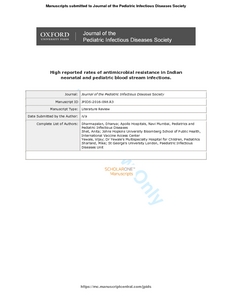Dharmapalan, D; Shet, A; Yewale, V; Sharland, M
(2017)
High Reported Rates of Antimicrobial Resistance in Indian Neonatal and Pediatric Blood Stream Infections.
J Pediatric Infect Dis Soc, 6 (3).
e62-e68.
ISSN 2048-7207
https://doi.org/10.1093/jpids/piw092
SGUL Authors: Sharland, Michael Roy
![[img]](https://openaccess.sgul.ac.uk/108464/7.hassmallThumbnailVersion/High%20reported%20rates%20of%20antimicrobial%20resistance%20in%20Indian%20neonatal%20and%20pediatric%20blood%20stream%20infections.pdf)  Preview |
|
PDF
Accepted Version
Available under License ["licenses_description_publisher" not defined].
Download (766kB)
| Preview
|
Abstract
Background.: There is real shortage of national data on antimicrobial resistance rates in Indian neonates and children. A descriptive review was conducted to determine the patterns of antimicrobial resistance in isolates of blood stream infection among hospitalized children in India. Methods.: Published and gray literature on antibiotic resistance in children was searched using "Google Scholar", "Scopus", and "PubMed" databases between January 2000 and July 2015. Studies were included if they were original articles that reported a minimum of 10 pathogenic bacterial isolates from the bloodstream within a pediatric population in India, and studies were excluded if they reported studies done during an outbreak or epidemic. Results.: A total of 1179 studies were screened, and 82 papers were identified as eligible for inclusion. Most studies (78.7%) were reported from neonatal intensive care units. Among a total of 50545 reported blood cultures, 14704 (29.1%) were positive. Staphylococcus aureus (median, 14.7%; IQR, 7.4%-25.6%) and Klebsiella pneumoniae (median, 26%; IQR, 16.7%-35.4%) were the commonest reported Gram-positive and Gram-negative pathogens, respectively. Approximately half of all S aureus isolates were reported as methicillin-resistant S aureus (median, 50%; IQR, 31.4%-65.1%). After age stratification, the median rate of resistance of common Gram-negative pathogens to ampicillin and gentamicin/amikacin were extremely high (K pneumoniae/ampicillin 95.9%; K pneumoniae/gentamicin 75%; Escherichia coli/ampicillin 92.9%; E coli/gentamicin 55.6%). Likewise, the median resistance of common Gram-negative blood stream isolates to cephalosporins were also high (K pneumoniae/cefotaxime 62.6%; E coli/cefotaxime 47.5%). Conclusions.: High rates of resistance to World Health Organization-recommended first-line treatment options for neonates and children have been identified in blood stream infections across India. There is an urgent need to both enhance antibiotic stewardship and infection prevention and control measures and consider urgently how to repurpose older antibiotics back into routine care in India.
| Item Type: |
Article
|
| Additional Information: |
This is a pre-copyedited, author-produced version of an article accepted for publication in Journal of the Pediatric Infectious Diseases Society following peer review. The version of record Dharmapalan, D; Shet, A; Yewale, V; Sharland, M (2017) High Reported Rates of Antimicrobial Resistance in Indian Neonatal and Pediatric Blood Stream Infections. J Pediatric Infect Dis Soc, Volume 6, Issue 3, 1 September 2017, Pages e62–e68. is available online at: https://doi.org/10.1093/jpids/piw092 |
| Keywords: |
India, MRSA., antimicrobial resistance, cephalosporins, children |
| SGUL Research Institute / Research Centre: |
Academic Structure > Infection and Immunity Research Institute (INII) |
| Journal or Publication Title: |
J Pediatric Infect Dis Soc |
| ISSN: |
2048-7207 |
| Language: |
eng |
| Dates: |
| Date | Event |
|---|
| 1 September 2017 | Published | | 18 February 2017 | Published Online | | 19 December 2016 | Accepted |
|
| Publisher License: |
Publisher's own licence |
| PubMed ID: |
28339675 |
 |
Go to PubMed abstract |
| URI: |
https://openaccess.sgul.ac.uk/id/eprint/108464 |
| Publisher's version: |
https://doi.org/10.1093/jpids/piw092 |
Statistics
Item downloaded times since 03 May 2017.
Actions (login required)
 |
Edit Item |



